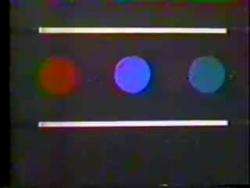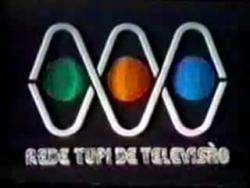Rede Tupi
 | |
| Type | Broadcast television network |
|---|---|
| Branding | Rede Tupi |
| Country | Brazil |
| Availability | Brazil |
| Founded |
September 18, 1950 by Assis Chateaubriand |
| Slogan | Tupi, mais calor humano |
Broadcast area | Brazil |
| Owner | Diários Associados |
Key people | Assis Chateaubriand |
Launch date | September 18, 1950 |
| Dissolved | July 18, 1980 |
Rede Tupi (Portuguese pronunciation: [ˈʁedʒi tuˈpi], also known as TV Tupi or formally as Rádio Difusora São Paulo S.A. was the first television network in South America. The network was owned by Diários Associados, who formed the Rede de Emissoras Associadas. Rede Tupi was founded and launched on September 18, 1950 by Assis Chateaubriand in São Paulo, initially broadcasting on Tupi Television Channel 3, whose first broadcast was on September 20 of that same year. Rede Tupi was later broadcast in 1960 on Tupi Television Channel 4 after the inauguration of TV Cultura (Culture TV), Channel 2, Rede Associada (Associated Network), and also a TV Station from Associadas. Their competitors were Rede Record, Channel 7, and Rede Excelsior (Network Excelsior).
In Rio de Janeiro, TV Tupi was broadcast on Tupi Channel 6, and had its own station and studios there. In Brasília, TV Tupi was retransmitted by TV Brasília on Channel 6. In Salvador, TV Tupi was retransmitted by TV Itapoan, on Channel 5. Other TV Stations were formed by the Rede de Emissoras Associadas (Network of Associated Broadcasters), all Tupi affiliates and directly operated stations.
History
Named for the Tupiniquim tribe in Brazil, Rede Tupi was a pioneer in television programming in South America, setting the tone for the best dramas, news programming, sports, theater and entertainment in the 1950s and 1960s such as TV de Vanguarda (Vanguard TV), O Repóter Esso (The Esso Reporter), Alo Docura, Clube dos Artistas (1952–80), Beto Rockfeller, O Mundo e das Mulheres (The World for Women) and many more. It led the way for the establishment of television stations throughout Brazil, and in 1960, beat other stations in broadcasting via satellite (the first Brazilian TV network to achieve such a feat) in honor of the formal opening of Brasilia.
Its success prompted other nations in the continent to have television stations. The network added new talent to Brazilian show business, which was then a thriving industry depending on movies and radio. During the 1960s its programs revolutionized television through animation, humor, comedy and children's shows plus the telenovelas that gave rise to the 1965 launch of its rival network in Rio de Janeiro, Rede Globo.
Tupi had its own mark in news: Rede Tupi de Noticias (Tupi News Network) became one of its successful broadcasts. The newscast was unique because it was broadcast three times each night. Ana Maria Braga was the main presenter. It had three sections: sports, local news and national/world news.
In 1964 it became Brazil's second television network to broadcast in color following Rede Excelsior in 1962. After its founder's death in 1968, the network, due to a crisis with its owners, transitioned itself becoming the first national television network in 1970, composed of its two main stations, Channels 4 and 6, its 7 other stations and 17 affiliate stations nationwide.
Tupi in 1972 joined other Brazilian stations in the move to full color TV broadcasts. On March 31 that very year Tupi's special program, Mais Cor em Sua Vida (More Color in Your Life) officially kicked off its color transmissions, and debuted a new logo in celebration, replacing the old number 6 logo used in Rio during its monochrome days.
After 29 years of continuous broadcast Rede Tupi became defunct on July 16 to 18, 1980 when its two stations in São Paulo (Tupi Channel 4) and Rio de Janeiro (Tupi Channel 6) shut down, together with its 7 other stations nationwide, by order of the federal government of Brazil - a military dictatorship at the time. The Department of National Telecommunications did not approve the planned extension of Rede Tupi's television concession. The Rio station signed-off for the last time on midday of the 18th, following the other stations the previous day. The final days of broadcasts at the network's Rio de Janeiro studios (including the 18-hour long vigil) were covered by various networks in Brazil, including Rede Bandeirantes.
It was succeeded by SBT (Brazilian Television System, then TVS, TV Studios Channel 4) of the Grupo Silvio Santos (Silvio Santos Group) of Silvio Santos later in August 1981 and by Rede Manchete (Network Manchete Channel 9), of the Bloch Editores (Bloch Editors) publishing group of Adolpho Bloch, in June 1983, the two stations using Rede Tupi's two channels in São Paulo and Rio de Janeiro (Tupi Channel 6 and Tupi Channel 4) as their own, operating from their own broadcasting centers.
Slogans
- 1950-1969: A pioneira (The pioneer)
- 1970-1979: Do tamanho do Brasil (As big as Brazil)
- 1972: Sistema Tupicolor, vamos por mais cor na sua vida (Tupicolor system, let's put more color in your life)
- 1973-1975: Tupi, Uma Estação de Emoções (Tupi, A Station of Emotions)
- 1979-1980: Tupi, mais calor humano (Tupi, more human warmth)
Idents
| Year | Ident |
|---|---|
| 1950 |  |
| 1972 |  |
| 1975 |  |
| 1978 |   |
| 1980 |   |
Main Broadcasting Channels
- TV Tupi São Paulo (PRF-3)/São Paulo - Tupi Channel 3 (1950–1960), Tupi Channel 4 (1960–1980)
- TV Tupi Rio de Janeiro (PRG-3)/Rio de Janeiro - Tupi Channel 6
O&O
- TV Brasília/Brasília - Channel 6 (Presently affiliated with RedeTV!)
- TV Itacolomi/Belo Horizonte - Channel 4 (Presently RedeTV!)
- TV Itapoan/Salvador - Channel 5 (Now Rede Record)
- TV Marajoara/Belém - Channel 2 (Presently with SBT, one of its first stations)
- TV Piratini/Porto Alegre - Channel 5(Now SBT)
- TV Goiânia/Goiânia - Channel 4 (Now Rede Record)
- TV Ceará/Fortaleza - Channel 2 (Now RedeTV!)
- TV Rádio Clube de Recife/Recife - Channel 6 (Now RedeTV!)
- TV Vitória/Vitória - Channel 6 (Affiliated with Rede Record)
- TV Borborema/Campina Grande - Channel 9 (Affiliated with SBT)
Affiliated broadcasters
- TV Sentinela/Óbidos-PA - Canal 7 (Now Rede Bandeirantes)
- TV Paraná/Curitiba - Canal 6 (Now CNT)
- TV Iguaçu/Curitiba - Canal 4 (de 1978 a 1980) (Now SBT)
- TV Cultura/Florianópolis - Canal 6 (Now Record News)
- TV Uberaba/Uberaba-MG - Canal 7 (Now Rede Bandeirantes)
- TV Equatorial/Macapá/AP (1979 and 1980) - Canal 8 (Now Record News)
- TV Tibagi/Apucarana-PR - Canal 11 (Now SBT)
- TV Coroados/Londrina-PR - Canal 3 (Now Rede Globo/RPC)
- TV Rio Preto/São José do Rio Preto-SP - Canal 8 (Now canal 7 Rede Record)
- TV Esplanada/Ponta Grossa-PR - Canal 7 (Now Rede Globo/RPC)
- TV Coligadas/Blumenau-SC - Canal 3 (Now Rede Globo/RBS)
- TV Altamira/Altamira-PA - Canal 6 (Now Rede Record)
- TV Sergipe/Aracaju-SE (1971 and 1975) - Canal 4 (Now Rede Globo)
- TV Atalaia/Aracaju-SE (1975 and 1980-present) - Canal 8 (Now Rede Record)
- TV Baré/Manaus-AM (1972 and 1980) - Canal 4 (Now Rede Record)